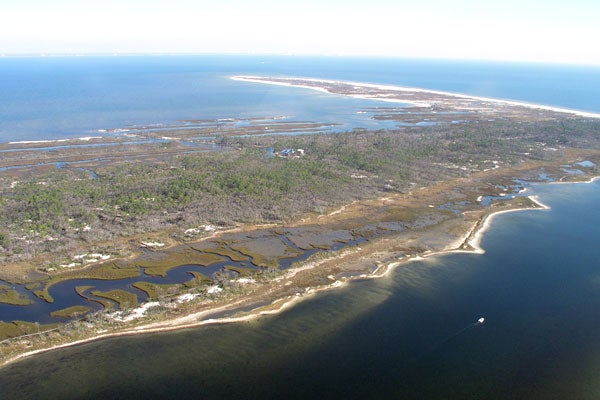Back Barrier Marsh: A Key Component of Caminada Headland Restoration
Earlier this week, Louisiana’s Coastal Protection and Restoration Authority (CPRA) highlighted completion of the Caminada Headland beach & dune restoration project. The restored areas of this headland are an essential part of one of our priority projects, Belle Pass to Caminada Pass Restoration – but they are only part of the picture! There’s more to barrier islands and headlands than sandy beaches and dunes.
An important part of healthy barrier islands and headlands is what’s called “back barrier marsh.” This is really just the salt marsh right behind the beach and dunes, attached to the barrier island.

The Pelican Island restoration project included beach, dune, and back barrier marsh restoration. Credit: Estelle Robichaux
Back barrier marsh is a critical component to coastal restoration because it provides vital wildlife habitat. Some bird species prefer marsh over beach or dune habitat for nesting and foraging. These marsh areas on the back side of barrier islands are also more protected from wind and waves, which means that fish can find safe habitat there as well. Smaller wildlife species might also find protection from land-based predators in back barrier marsh, once mangroves establish. So it’s important to incorporate all of these elements – beach, dune and back barrier marsh – into barrier island restoration.
Back barrier marsh can also play a significant role during extreme weather events, like tropical storms or hurricanes. It can help reduce wave energy, and sediment that is washed away by waves or destabilized by wind during minor storms may be recaptured in the marsh. Having a well-vegetated back barrier marsh component can also help reduce how much the barrier island moves over time.

Cat Island in Mississippi was hit hard by Hurricane Katrina in 2005. The beach and shoreline eroded away, but the island stayed stable because of healthy back barrier marsh and maritime forest. Credit: USGS
Normally, back barrier marsh restoration is part of the barrier island restoration projects that CPRA designs. But because the Caminada Headland project was so big, the state has been designing and restoring it in phases. There are two back barrier marsh projects for the Caminada Headland currently in engineering & design, and we are hopeful that funds for construction of these projects will be granted soon.
Restoration of the Caminada Headland beach & dunes has been very impressive, but restoration of the back barrier marsh will truly make this a large-scale ecosystem restoration project!
To learn more about barrier islands and headlands, from how they are formed naturally to restoration plans across the coast, check out our fact sheet.